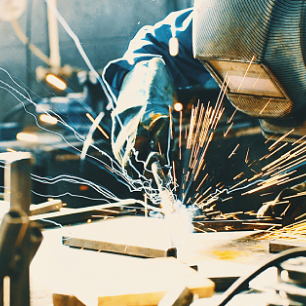Jump to:
Flux Core Arc Welding (FCAW): What It Is, How It Works, and How to Fix Common Issues
What Is Flux Core Welding?
Flux Core Arc Welding (FCAW) is a semi-automatic or automatic arc welding process built for speed, strength, and versatility that uses a continuously fed consumable electrode filled with flux. Unlike solid wire used in MIG welding, flux core wire has a hollow center packed with fluxing agents. These agents help protect the weld pool, stabilize the arc, and add alloying elements.
There are two main types of flux core welding wires:
Self-Shielded Flux Core (FCAW-S): The flux in the wire generates the shielding gas, making it portable and ideal for outdoor jobs where wind can blow away traditional shielding gas.
Gas-Shielded Flux Core (FCAW-G): Uses both flux and an external shielding gas, producing cleaner welds often preferred in fabrication shops.
A Brief History of FCAW
Flux core arc welding was developed in the 1950s as a way to improve productivity compared to stick welding (SMAW). It combined the high deposition rates of MIG with the portability of flux shielding, making it a go-to method for industries like construction, shipbuilding, and pipeline work.
Over the years, improvements in flux core wire types and flux formulations expanded its applications. Today, FCAW is widely used for thick sections, outdoor welding, and structural steel work where reliability matters.
Flux Core vs MIG Welding: What’s the Difference?
A common question for beginners is how flux core compares to MIG welding. Both processes use a wire-fed gun, but MIG requires a cylinder of shielding gas, while flux core wire makes its own protection (self-shielded) or combines flux with external gas (gas-shielded).
MIG welding is cleaner, producing less spatter and requiring less post-weld cleanup.
Flux core welding handles dirty surfaces better, works outdoors in windy conditions, and penetrates deeper on thicker steel.
If you’re new to welding and trying to choose between a flux core welder and a MIG welder, think about your projects. MIG shines in the shop; flux core shines in the field.
Can You Weld Aluminum with a Flux Core Welder?
Another hot search: Can you weld aluminum with flux core wire? The short answer is no, not effectively. Flux core wire for aluminum doesn’t exist in a practical, commercially available form. If you need to weld aluminum, a MIG welder with a spool gun or a TIG welder is the better choice.
Troubleshooting Self-Shielded FCAW: Common Problems and Fixes
Even though flux core welding is versatile, it’s not immune to challenges. Here are a few common problems and how to fix them:
Excessive Spatter
Cause: Too much voltage or incorrect stickout.
Fix: Adjust your settings, and keep stickout between ¾"–1¼".
Porosity (tiny holes in the weld)
Cause: Contaminated base metal, damp wire, or improper gun angle.
Fix: Clean the work surface thoroughly, store flux core wire properly, and maintain a steady 10–20° drag angle.
Lack of Fusion
Cause: Travel speed too fast or voltage too low.
Fix: Slow down, and check that your voltage/amperage match the wire size.
Burnback (wire fusing to the contact tip)
Cause: Stickout too short or wire feed speed too slow.
Fix: Keep proper stickout and balance your feed speed with voltage.
Tips for Beginners Using a Flux Core Welder
Start with flux core welding for beginners tutorials or training videos before striking an arc.
Practice on scrap metal to dial in your flux core settings before working on critical joints.
Read the manufacturer’s recommendations for flux core wire types, since the right match matters for performance.
Final Bead
Flux core welding (FCAW) has earned its spot as one of the most versatile processes in the welding world. From outdoor construction sites to fabrication shops, it’s a method built for productivity and strength. By understanding the basics, comparing FCAW to MIG, knowing its limits with aluminum, and learning how to troubleshoot common issues, welders can get the most out of their flux core welder—without unnecessary frustration.


